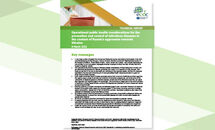Operational public health considerations for the prevention and control of infectious diseases in the context of Russia’s aggression towards Ukraine
A very large number of people from Ukraine are fleeing the country and entering the European Union (EU) countries bordering Ukraine (Hungary, Poland, Romania, Slovakia) and the EU-neighbourhood country of the Republic of Moldova. Those fleeing Ukraine - mainly women and children - are currently dispersing into communities, but as more people congregate at border crossings it is likely that they will also need to be housed in reception centres.
Executive summary
- This operational document focuses on infectious disease vulnerabilities of those fleeing from Ukraine, and the associated requirements for infection prevention and control. It is important to note, however, that these are just few of the risks to the health and well-being of the displaced people, and that the measures described in this document should be part of more generalised health measures provided in support of those who have been displaced.
- Public health authorities should increase awareness among their community healthcare providers regarding the need to ensure access to services and continuity of vaccination programmes, and to be aware of the vulnerability of displaced people to infectious diseases. Doctors should be informed so that they can adjust their diagnostic and reporting algorithms accordingly. This should be an integral part of the overall provision of healthcare to those fleeing Ukraine, as should the diagnosis and treatment of chronic disease and mental and psychosocial health.
- Ensuring continuity of routine vaccinations and addressing gaps in prior vaccination histories is an essential element of the public health support for displaced people. In this context, ensuring vaccination coverage against poliomyelitis, measles and COVID-19 should be a priority. Vaccination acceptance also needs to be assessed and addressed among those fleeing Ukraine.
- Surveillance systems should be enhanced by increasing awareness among health professionals taking care of displaced people, to ensure that vaccine-preventable diseases and other communicable diseases are appropriately detected.
- Syndromic surveillance should be considered for those accommodated in reception centres.
- In people presenting with traumatic wounds, healthcare providers should be made aware that infections associated with these injuries can often include infection due to multidrug-resistant organisms. Diagnostic and treatment procedures should therefore be appropriate for identifying and managing such organisms.
- Health risk communication activities should follow the standard principles of consistency and clarity and attempt to acknowledge and clear up any uncertainties that may exist.
Download
Related reports
Publication data
Infographic
Infographic: Vaccinations to be offered in the absence of documented evidence of prior vaccination
Vaccinations to be offered in the absence of documented evidence of prior vaccination.
Infographic
Infographic: Infectious diseases to be considered for differential diagnosis among displaced people
Infectious diseases to be considered for differential diagnosis among displaced people in addition to the more common causes for clinical presentation.






